VIDEO: Confronted by Hubert all others back off
Video recorded by Fleur, LK forum
Translation Liis
Red deer Punahirv Cervus elaphus
Red deer gather in bachelor flocks for the winter – the mating period ended about a month ago, the aggressivity of the stags has calmed down and even the neck muscles are not as thick and ready for fight as before.
Winter is spent peacefully but the hierarchy ladder is recognized throughout the year, see the video.
 Latest news
Latest news
 Loodusemees.ee - the day in pictures
Loodusemees.ee - the day in pictures Videos
Videos
 My Forest
My Forest


